seymour • any • scotland ⥬trainee celticist & linguist ⥪ ⥬ certified transfagdyke ⥪ ⥬{my ao3} {writing} ⥪
Don't wanna be here? Send us removal request.
Text

IT FUCKIN YURI DAAAAAAAAAAAY
68K notes
·
View notes
Text
"can you explain this gap in your resume" Oh yeah sorry i got sent to the 1300s and i had to fight evil skeletons
39K notes
·
View notes
Text
i hate it when customers get mad about policy and go “well i’ve always thought it worked differently” like ok. when i was a kid i thought the drains in sinks and bathtubs lead to Hell and i would pour things down them for the dead people. it turns out that you can think things that aren’t true
73K notes
·
View notes
Text
during the work day my rage metre builds up, allowing me to unleash a powerful & ill advised special attack around 4pm
4K notes
·
View notes
Text
myths about sinking britain
“there is no historical precedent for sinking britain!” doggerland, which connected britain to the european mainland, was submerged by water in 6500BC. there is precedent for sinking britain.
“it is unfeasible to sink britain!” britain is strategically located to allow many nations to co-operate in its sinking
“sinking britain would raise sea levels!” the netherlands already has dams
“sinking britain would cause more problems geopolitically than it would solve!” we simply won’t know this until we sink britain
32K notes
·
View notes
Text
There's something hilarious about how so much subsequent media has positioned Vampires and Werewolves as, like, binary opposite entities, and then you read Dracula (1897) and realize that wolves are that guy's preferred solution to every problem. You'd say something to Dracula about "ah yes, werewolves, vampires' great eternal enemies," and he'd just be like "you mean my subcontractors?"
69K notes
·
View notes
Text
dog motif is so funny because it was a real literal motif in hit show succession and then people started being like oh this is a general trope that describes whenever a character is subservient!!! no dude. they put roman in a cage.
2K notes
·
View notes
Text
god im infected by that posting style that's like "posting about my thing #my thing" i just got back to my apartment and my first thought had to go and formulate itself as damn im so sleepy i haven't even had my tea #mytea
19K notes
·
View notes
Text
they dont tell you this but like half of adulthood is just washing the same FUCKING pan
37K notes
·
View notes
Photo






The Constellations of Summer, Lia Halloran
3K notes
·
View notes
Photo






The Constellations of Summer, Lia Halloran
3K notes
·
View notes
Text
sir i mean no disrespect but i need you to bounce on it. Expeditiously
4K notes
·
View notes
Text
honestly fucking fascinating that people will pretty universally understand that thin people can be naturally predisposed to thinness regardless of what they eat or their activity level, but that so many of the same people cannot possibly fathom that fat people could have similar dispositions or that there could be any factors more complex than a "lack of self control."
83K notes
·
View notes
Text

Hidden For 2,000 Years: UK’s Biggest Iron Age Hoard Unearthed
Iron age hoard found in North Yorkshire could change Britain’s history.
One of the biggest and most important iron age hoards ever found in the UK has been revealed, potentially altering our understanding of life in Britain 2,000 years ago.
More than 800 objects were unearthed in a field near the village of Melsonby, North Yorkshire. They date back to the first century, around the time of the Roman conquest of Britain under Emperor Claudius, and are almost certainly associated with a tribe called the Brigantes who controlled most of northern England.
The objects include parts from wagons and/or chariots including 28 iron tyres, elaborate harnesses for at least 14 horses, bridle bits, ceremonial spears and two beautifully ornate cauldrons, one of which was probably used as a wine mixing bowl.
Experts involved in the find, described as internationally important, say the objects may lead to a reassessment of how we understand subjects such as wealth, status, trade and travel among Britain’s iron age tribes.
The hoard was discovered and reported just before Christmas 2021 by a metal detectorist, Peter Heads, who got a reading, dug a hole and realised he needed expert help.


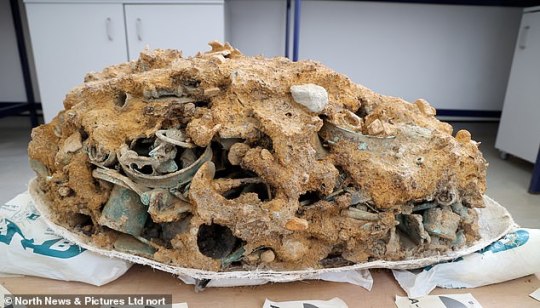
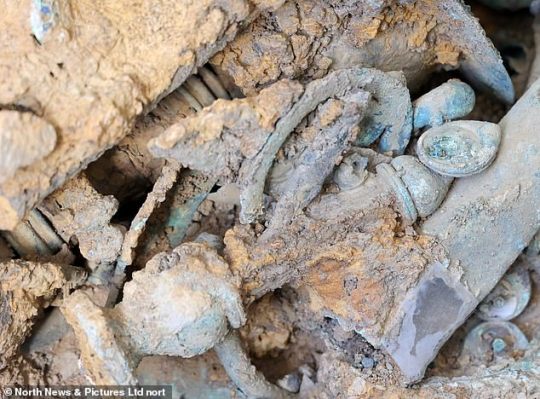
He contacted Prof Tom Moore, the head of archaeology at Durham University, who had been conducting research in the area. Moore saw right away the potential significance of what had been uncovered but had no idea it would be of such a jaw-dropping scale.
“Finding a hoard or collection of 10 objects is unusual, it’s exciting, but finding something of this scale is just unprecedented,” he said. “We were not expecting it … I think for everybody on the team, we were just lost for words.”
After securing £120,000 funding from Historic England, excavations took place in 2022, including the removal of one large block of tangled metal objects that may have been in a bag together.
Moore said the horse harnesses pulling the wagons or chariots were beautifully decorated with coral and coloured glass and, with the vehicles, would have been quite a sight. “They would have looked incredible,” he said. “It just emphasises that these people had real status and real wealth.
“Some people have regarded the north as being impoverished compared to the iron age of the south of Britain. This shows that individuals there had the same quality of materials and wealth and status and networks as people in the south.
“They challenge our way of thinking and show the north is definitely not a backwater in the iron age. It is just as interconnected, powerful and wealthy as iron age communities in the south.”
Keith Emerick, an inspector of ancient monuments at Historic England, said the decision to provide funding was agreed the same day Moore contacted him. “The scale of the find and the material in it is completely unparalleled in this country,” he said. “To have something like this from the north of England is really exceptional.”
He recalled seeing the objects laid out at Durham. “It was one of those wow moments really, just to see how rich and splendid and mind-bogglingly beautiful some of it is. It has been a once-in-a-lifetime find for everyone involved.”
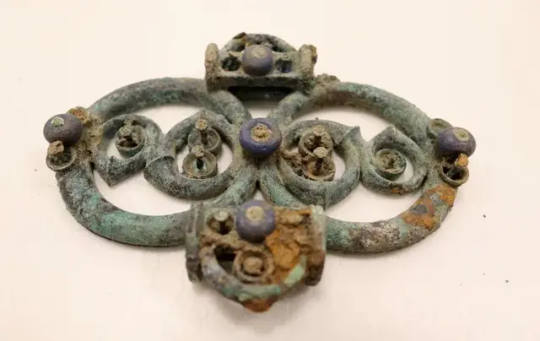
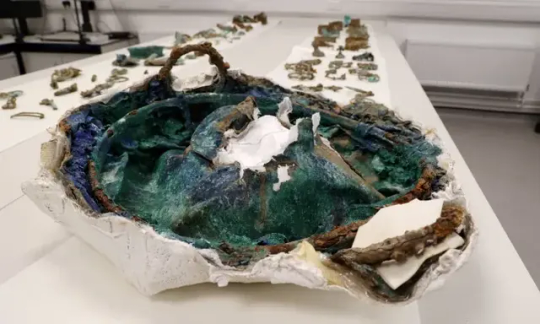

Moore said the working assumption was that the high-status objects belonged to someone who was “probably part of a network of elites across Britain, into Europe and even the Roman world”.
A lot of the material had been burned, suggesting it may have been part of a funerary pyre for an elite person before being thrown in a ditch.
Moore said one of the most exciting parts of the discovery was the first evidence of four-wheeled wagons used by iron age tribes in Britain, possibly imitating vehicles seen in continental Europe. He said: “We’re going to have spend years thinking what did these vehicles look like, where did they come from?”
The Melsonby hoard has been valued at £254,000 and a fundraising campaign to secure it for the nation will be launched by the Yorkshire Museum in York.

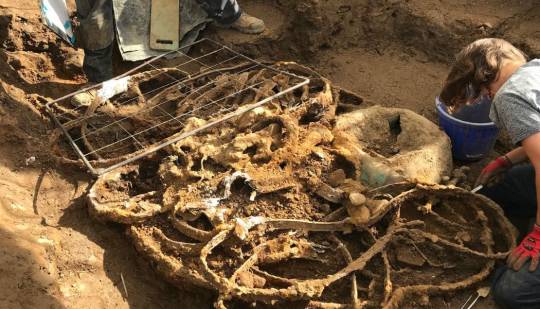

Its discovery was announced jointly by Historic England, Durham University and the British Museum.
The heritage minister, Chris Bryant, said the hoard was an extraordinary find “which will help us to better understand the fabric of our nation’s history”.
Emerick said the find posed lots of interesting questions. Julius Caesar led the first Roman expeditions to Britain a century before Claudius’s invasion and the Brigantes would have known about them. “You kind of look at this material and ask is this people thinking about the end of something, or are they thinking about the beginning of something?”
By Mark Brown North.


342 notes
·
View notes
